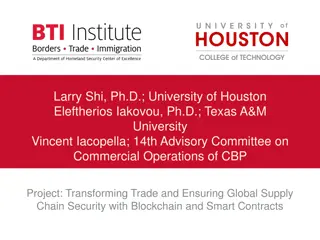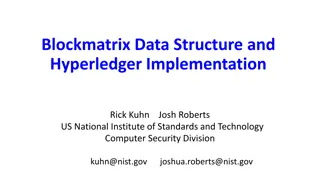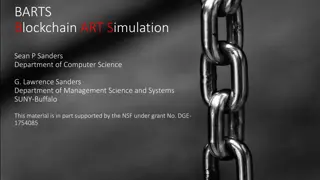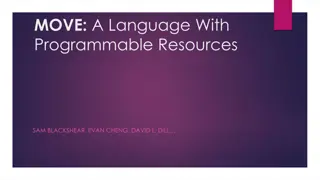Understanding Move Language and Libra Blockchain
Explore Move Language, designed for the Libra Blockchain with programmable resources ensuring safety and expressivity. Learn about Libra's mission to create a stable digital currency and the abstract view of a blockchain system. Discover how Move facilitates encoding digital assets and addresses physical asset properties like scarcity and access control in an open system.
Download Presentation

Please find below an Image/Link to download the presentation.
The content on the website is provided AS IS for your information and personal use only. It may not be sold, licensed, or shared on other websites without obtaining consent from the author. Download presentation by click this link. If you encounter any issues during the download, it is possible that the publisher has removed the file from their server.
E N D
Presentation Transcript
MOVE A LANGUAGE WITH PROGRAMMABLE RESOURCES
WHAT WILL WE SEE TODAY? The Libra Blockchain Issues with digital asset representation on the blockchain. Move's design solutions to these issues. The programming model and key features of Move Move s technical details and it s virtual machine design Putting It All Together
WHAT IS THE MOVE LANGUAGE? Programming language designed for the Libra Blockchain A language with programmable resources A resource can never be copied or discarded, only moved between program storage locations The safety and expressivity of Move have enabled us to implement significant parts of the Libra protocol in Move
WHAT IS LIBRA? Facebook s trial to create their own blockchain Renamed to Diem Aiming to create a stable and globally accessible digital currency It aims to provide a secure and low-cost way for people to transfer money across borders
AN ABSTRACT VIEW OF A BLOCKCHAIN A blockchain is a replicated state machine Replicators in the system are known as validators Users of the system send transactions to validators Each validator that execute a transaction, transition its internal state machine from the current state to a new state Validators follow a consensus protocol for collectively defining and maintaining the replicated state
ENCODING DIGITAL ASSETS IN AN OPEN SYSTEM The Libra Blockchain is an open system The role of the language is to decide how transitions and states are represented The state of the Blockchain must be able to encode the owners of digital assets and allow the transfer of assets The state transition function must be able to recognize if state transition is invalid and reject it
PHYSICAL ASSETS PROPERTIES There are two properties of physical assets that are difficult to encode in digital assets: Scarcity Access control The goal is to design a system that is expressive enough to allow a money transfer, yet constrained enough to prevent any user from violating the scarcity or access control properties.
SIMPLEST PROPOSAL Directly encode the update to the state in the transaction script: The proposal does not enforce scarcity Scarcity is an important property of valuable physical assets
SECOND PROPOSAL - SCARCITY: Under this scheme, executing a valid transaction script enforces scarcity by conserving the number of coins in the system Alice can no longer create coins out of thin air
SECOND PROPOSAL - SCARCITY: We still have a problem: The proposal does not enforce Access Control nothing in the evaluation rule will stop Bob from sending the transaction: Alice, 100, Bob
SECOND PROPOSAL SCARCITY AND ACCESS CONTROL: We can address this by adding an access control mechanism based on digital signatures: This new rule solves the problem by using the unforgeability of digital signatures.
WHY WE NEED BLOCKCHAIN LANGUAGES 1. Indirect representation of assets 2. Scarcity is not extensible 3. Access control is not flexible
3. MOVE GOAL The Libra mission is to enable a simple global currency and financial infrastructure that empowers billions of people Move s requitements Move is designed with four key goals: First class assets, flexability, safety, verifiable
FIRST CLASS RESOURCES Ability to define custom resource types Resources are ordinary program values.
FIRST CLASS RESOURCES The Libra coin is implemented as a regular Move resource. Move must support operations on these resources: Creating resources. Modifying resources. Destroying resources.
FIRST CLASS RESOURCES Move programmers can protect access to these critical operations with modules. declares resource types and procedures. A model can use other model resources and procedures.
FLEXIBILITY Flexibility here refers to the ability to write and organize code in a manner that allows for easy changes, reuse, and extension Move adds flexibility to Libra by transaction scripts. can perform expressive one-off behaviors or reusable behaviors
FLEXIBILITY Move modules enable a different kind of flexibility modules/resources/procedures is similar to classes/objects/methods. Key Differences: Resource Declaration. Procedures and Methods.
SAFTY Must satisfy key properties : resource safety, type safety, and memory safety High-Level Language with Compiler Low-Level Assembly with Runtime Checks
SAFTY Move s Approach: Typed Bytecode Typed Bytecode: Higher-level than assembly but lower-level than high level languages. Bytecode Verifier: Checks for safety properties on-chain before execution. Bytecode Interpreter: Executes verified bytecode directly.
VERIFIABILITY Ideally: check every safety property of Move programs Approach to Verifiability: On-Chain Verification: Perform lightweight checks on-chain to ensure key safety properties. Off-Chain - Static Verification: Support advanced off-chain verification tools to analyze programs before execution.
DESIGN DECISIONS FOR STATIC VERIFICATION No dynamic dispatch: Every function call target is determined at compile time. Limited mutability: Every mutation to a Move value occurs through a reference. Move s bytecode verifier uses a borrow checking scheme.
DESIGN DECISIONS FOR STATIC VERIFICATION Modularity : Code is organized into modules enforcing data abstraction and encapsulation. Efficiently check for runtime failures and program-specific properties. Simplified language design facilitates accurate and efficient analysis.
RESOURCE SAFETY THE GUARANTEES THAT MOVE RESOURCES CAN NEVER BE COPIED, REUSED, OR LOST.
PEER-TO-PEER PAYMENT TRANSACTION SCRIPT public main(payee: address, amount: u64) { let coin: 0x0.Currency.Coin=0x0.Currency.withdraw_from_sender(copy(amount)); 0x0.Currency.deposit(copy(payee), move(coin)); }
COPY A COIN public main(payee: address, amount: u64) { let coin:0x0.Currency.Coin=0x0.Currency.withdraw_from_sender(copy(amount)); 0x0.Currency.deposit(copy(payee), copy(coin)); }
DUPLICATE A COIN public main(payee: address, amount: u64) { let coin: 0x0.Currency.Coin =0x0.Currency.withdraw_from_sender(copy(amount)); 0x0.Currency.deposit(copy(payee), move(coin)); 0x0.Currency.deposit(copy(some_other_payee), move(coin)); }
LOSE TRUCK OF A COIN public main(payee: address, amount: u64) { let coin: 0x0.Currency.Coin=0x0.Currency.withdraw_from_sender(copy(amount)); } These guarantees go beyond what is possible for physical assets like paper currency.
CURRENCY MODULE Move has two different kinds of programs: transaction scripts and modules. Transaction scripts are included in each user-submitted transaction and invoke procedures of a module to update the global state.
THE GLOBAL STATE The global state is structured as a map from account addresses to accounts. Each account can contain zero or more modules and one or more resource values. Accounts can contain at most one resource value of a given type and at most one module with a given name. Modules can contain a resource type named Coin that is managed by the module.
PROCEDURES AND TRANSACTION SCRIPTS Signature: visibility, typed formal parameters, return types. Declaration : signature, typed local variables, array of bytecode instructions. Visibility : Internal Procedures: Invoked only by other procedures within the same module. Public Procedures: invoked by any module or transaction script
BYTECODE INTERPRETER The blockchain state is updated by a transaction script that can invoke public procedures of any module that is currently published under an account. In Move, a procedure is uniquely identified by the module it belongs to and its signature (the name and types of its parameters and return values).
BYTECODE INTERPRETER The Call bytecode instruction in Move requires a unique procedure ID as input. Move enforces that modules that were published earlier in the linear transaction history.
BYTECODE INTERPRETER Move bytecode instructions are executed by a stack-based interpreter An instruction consumes operands from the stack and pushes results onto the stack
BYTECODEINTERPRETER The bytecode interpreter supports procedure calls Input values passed to the callee and output values returned to the caller are also communicated by the stack
BYTECODE INTERPRETER The bytecode interpreter executing operations in sequence unless there is a branch operation that causes a jump When the callee wishes to return, it pushes the return values onto the stack and invokes the Return instruction.
INSTRUCTIONS 1 Move supports six broad categories of bytecode instructions: CopyLoc/MoveLoc: for copying/moving data from local variables to the stack StoreLoc: moving data from the stack to local variables
INSTRUCTIONS 2 Operations on typed stack values operations on stack operands Push constants 5 11 5 5 6 6
INSTRUCTIONS 3 : MODULE BUILTINS Pack and Unpack: Creating/destroying the module s declared types, MoveToSender/MoveFrom: For publishing/unpublishing the module s types BorrowField: Acquiring a reference to a field
INSTRUCTIONS 4 - REFERENCE-RELATED ReleaseRef: destroying a reference FreezeRef : converting a mutable to immutable ReadRef, WriteRef Reading, Writing references
INSTRUCTIONS 5&6 Control-flow operations Blockchain-specific builtin operations
NATIVE Move provides cryptographic functions as native procedures within standard library modules instead of as direct bytecode instructions.
BYTECODE VERIFIER Goal: enforce safety properties for any module and any transaction script submitted for publication. The bytecode verifier enforces general safety properties that must hold for any well formed Move program. The binary format of a Move module or transaction script encodes a collection of tables of entities
BYTECODE VERIFIER The checks performed by the verifier fall into three categories: Structural checks: to ensure that the bytecode tables are well-formed Semantic checks on procedure bodies. Linking uses of struct types and procedure signatures against their declaring modules.
VIRTUAL MACHINE: PUTTING IT ALL TOGETHER MOVE The role of the Move virtual machine is to execute a block ? of transactions from a global state and produce a transaction effect ? representing modifications to the global state Transactions in a block are executed sequentially by the VM























